Evaluating and Managing Change in Health and Social Care: A Report
VerifiedAdded on 2021/01/02
|11
|3585
|349
Report
AI Summary
This report provides a comprehensive analysis of change management within the UK's Health and Social Care (HSC) sector, focusing on the National Health Service (NHS). It examines factors driving change, including legislation, economic shifts, and leadership adjustments, while also addressing associated challenges like financial constraints, workforce shortages, and policy limitations. The report explores strategies for measuring recent changes, such as data collection, research, and qualitative/quantitative methods, alongside an assessment of their impact on services through employee ratings and feedback analysis. Furthermore, it delves into the evaluation of these changes, emphasizing the need for employee development and community-based care, and concludes by examining how services respond to these changes through quality monitoring, leadership adjustments, and service user involvement. The report highlights the principles of change management, including Kotter's model and the importance of planning, communication, and employee engagement to successfully navigate organizational transformations within the healthcare landscape.

Facilitating Change in
Health and Social care
Health and Social care
Paraphrase This Document
Need a fresh take? Get an instant paraphrase of this document with our AI Paraphraser
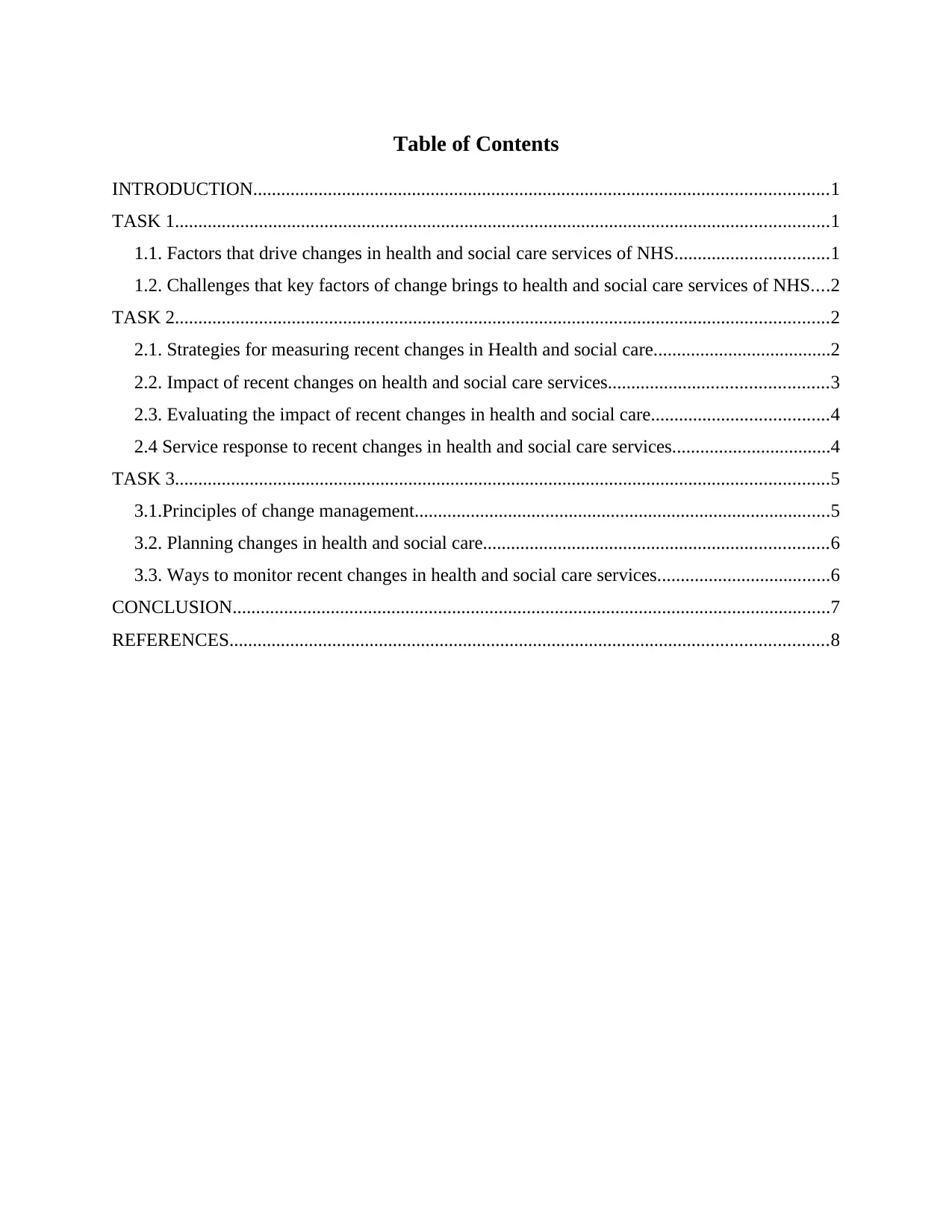
Table of Contents
INTRODUCTION...........................................................................................................................1
TASK 1............................................................................................................................................1
1.1. Factors that drive changes in health and social care services of NHS.................................1
1.2. Challenges that key factors of change brings to health and social care services of NHS....2
TASK 2............................................................................................................................................2
2.1. Strategies for measuring recent changes in Health and social care......................................2
2.2. Impact of recent changes on health and social care services...............................................3
2.3. Evaluating the impact of recent changes in health and social care......................................4
2.4 Service response to recent changes in health and social care services..................................4
TASK 3............................................................................................................................................5
3.1.Principles of change management.........................................................................................5
3.2. Planning changes in health and social care..........................................................................6
3.3. Ways to monitor recent changes in health and social care services.....................................6
CONCLUSION................................................................................................................................7
REFERENCES................................................................................................................................8
INTRODUCTION...........................................................................................................................1
TASK 1............................................................................................................................................1
1.1. Factors that drive changes in health and social care services of NHS.................................1
1.2. Challenges that key factors of change brings to health and social care services of NHS....2
TASK 2............................................................................................................................................2
2.1. Strategies for measuring recent changes in Health and social care......................................2
2.2. Impact of recent changes on health and social care services...............................................3
2.3. Evaluating the impact of recent changes in health and social care......................................4
2.4 Service response to recent changes in health and social care services..................................4
TASK 3............................................................................................................................................5
3.1.Principles of change management.........................................................................................5
3.2. Planning changes in health and social care..........................................................................6
3.3. Ways to monitor recent changes in health and social care services.....................................6
CONCLUSION................................................................................................................................7
REFERENCES................................................................................................................................8
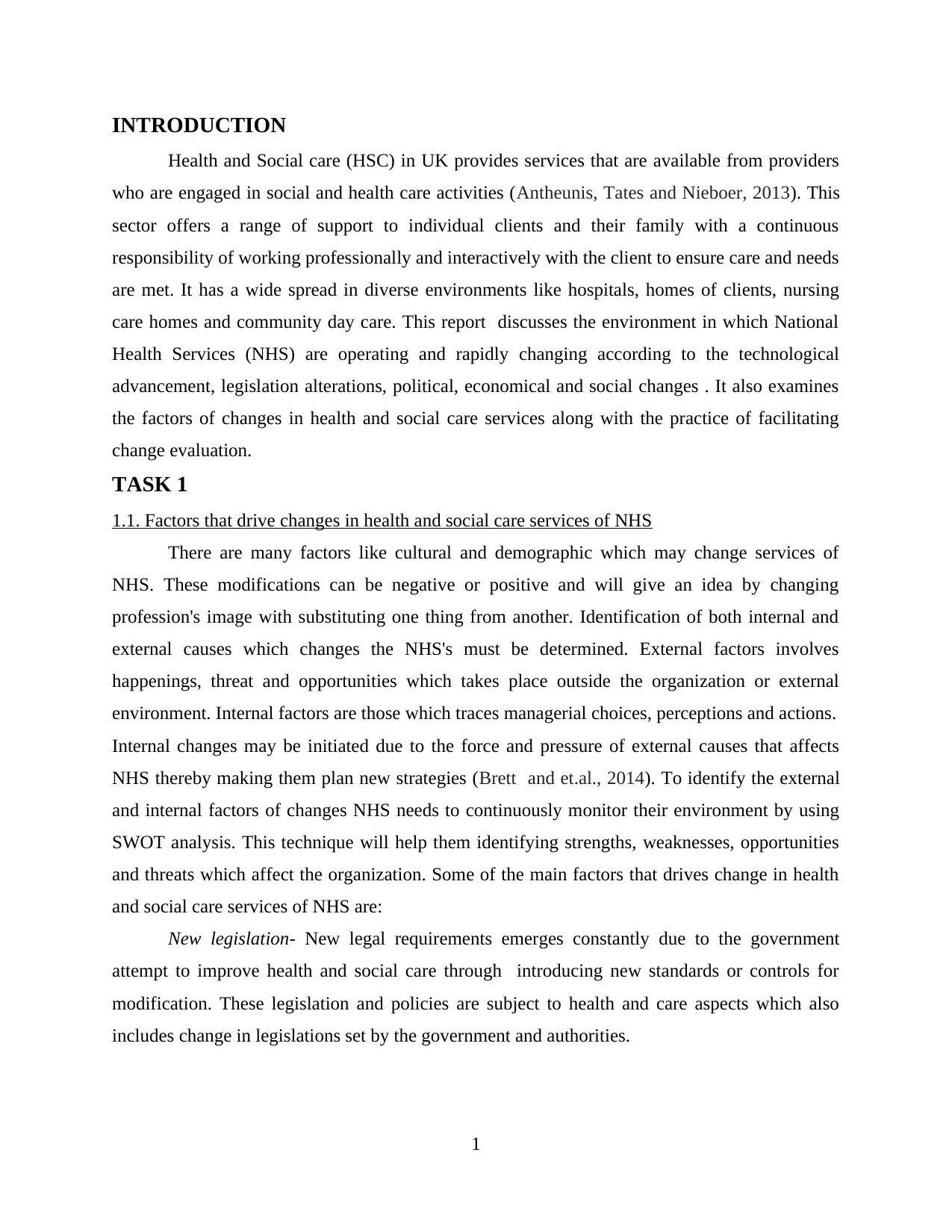
INTRODUCTION
Health and Social care (HSC) in UK provides services that are available from providers
who are engaged in social and health care activities (Antheunis, Tates and Nieboer, 2013). This
sector offers a range of support to individual clients and their family with a continuous
responsibility of working professionally and interactively with the client to ensure care and needs
are met. It has a wide spread in diverse environments like hospitals, homes of clients, nursing
care homes and community day care. This report discusses the environment in which National
Health Services (NHS) are operating and rapidly changing according to the technological
advancement, legislation alterations, political, economical and social changes . It also examines
the factors of changes in health and social care services along with the practice of facilitating
change evaluation.
TASK 1
1.1. Factors that drive changes in health and social care services of NHS
There are many factors like cultural and demographic which may change services of
NHS. These modifications can be negative or positive and will give an idea by changing
profession's image with substituting one thing from another. Identification of both internal and
external causes which changes the NHS's must be determined. External factors involves
happenings, threat and opportunities which takes place outside the organization or external
environment. Internal factors are those which traces managerial choices, perceptions and actions.
Internal changes may be initiated due to the force and pressure of external causes that affects
NHS thereby making them plan new strategies (Brett and et.al., 2014). To identify the external
and internal factors of changes NHS needs to continuously monitor their environment by using
SWOT analysis. This technique will help them identifying strengths, weaknesses, opportunities
and threats which affect the organization. Some of the main factors that drives change in health
and social care services of NHS are:
New legislation- New legal requirements emerges constantly due to the government
attempt to improve health and social care through introducing new standards or controls for
modification. These legislation and policies are subject to health and care aspects which also
includes change in legislations set by the government and authorities.
1
Health and Social care (HSC) in UK provides services that are available from providers
who are engaged in social and health care activities (Antheunis, Tates and Nieboer, 2013). This
sector offers a range of support to individual clients and their family with a continuous
responsibility of working professionally and interactively with the client to ensure care and needs
are met. It has a wide spread in diverse environments like hospitals, homes of clients, nursing
care homes and community day care. This report discusses the environment in which National
Health Services (NHS) are operating and rapidly changing according to the technological
advancement, legislation alterations, political, economical and social changes . It also examines
the factors of changes in health and social care services along with the practice of facilitating
change evaluation.
TASK 1
1.1. Factors that drive changes in health and social care services of NHS
There are many factors like cultural and demographic which may change services of
NHS. These modifications can be negative or positive and will give an idea by changing
profession's image with substituting one thing from another. Identification of both internal and
external causes which changes the NHS's must be determined. External factors involves
happenings, threat and opportunities which takes place outside the organization or external
environment. Internal factors are those which traces managerial choices, perceptions and actions.
Internal changes may be initiated due to the force and pressure of external causes that affects
NHS thereby making them plan new strategies (Brett and et.al., 2014). To identify the external
and internal factors of changes NHS needs to continuously monitor their environment by using
SWOT analysis. This technique will help them identifying strengths, weaknesses, opportunities
and threats which affect the organization. Some of the main factors that drives change in health
and social care services of NHS are:
New legislation- New legal requirements emerges constantly due to the government
attempt to improve health and social care through introducing new standards or controls for
modification. These legislation and policies are subject to health and care aspects which also
includes change in legislations set by the government and authorities.
1
⊘ This is a preview!⊘
Do you want full access?
Subscribe today to unlock all pages.

Trusted by 1+ million students worldwide
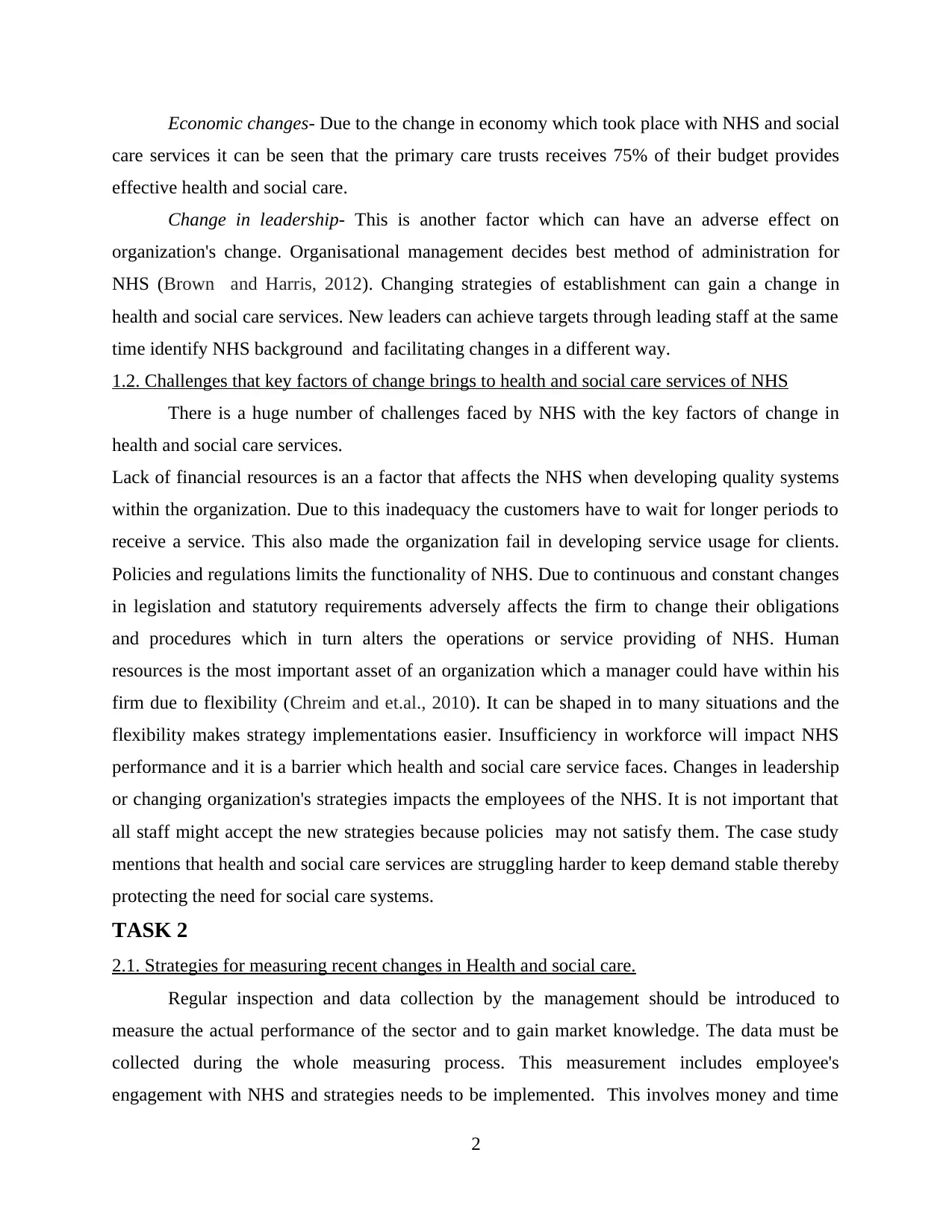
Economic changes- Due to the change in economy which took place with NHS and social
care services it can be seen that the primary care trusts receives 75% of their budget provides
effective health and social care.
Change in leadership- This is another factor which can have an adverse effect on
organization's change. Organisational management decides best method of administration for
NHS (Brown and Harris, 2012). Changing strategies of establishment can gain a change in
health and social care services. New leaders can achieve targets through leading staff at the same
time identify NHS background and facilitating changes in a different way.
1.2. Challenges that key factors of change brings to health and social care services of NHS
There is a huge number of challenges faced by NHS with the key factors of change in
health and social care services.
Lack of financial resources is an a factor that affects the NHS when developing quality systems
within the organization. Due to this inadequacy the customers have to wait for longer periods to
receive a service. This also made the organization fail in developing service usage for clients.
Policies and regulations limits the functionality of NHS. Due to continuous and constant changes
in legislation and statutory requirements adversely affects the firm to change their obligations
and procedures which in turn alters the operations or service providing of NHS. Human
resources is the most important asset of an organization which a manager could have within his
firm due to flexibility (Chreim and et.al., 2010). It can be shaped in to many situations and the
flexibility makes strategy implementations easier. Insufficiency in workforce will impact NHS
performance and it is a barrier which health and social care service faces. Changes in leadership
or changing organization's strategies impacts the employees of the NHS. It is not important that
all staff might accept the new strategies because policies may not satisfy them. The case study
mentions that health and social care services are struggling harder to keep demand stable thereby
protecting the need for social care systems.
TASK 2
2.1. Strategies for measuring recent changes in Health and social care.
Regular inspection and data collection by the management should be introduced to
measure the actual performance of the sector and to gain market knowledge. The data must be
collected during the whole measuring process. This measurement includes employee's
engagement with NHS and strategies needs to be implemented. This involves money and time
2
care services it can be seen that the primary care trusts receives 75% of their budget provides
effective health and social care.
Change in leadership- This is another factor which can have an adverse effect on
organization's change. Organisational management decides best method of administration for
NHS (Brown and Harris, 2012). Changing strategies of establishment can gain a change in
health and social care services. New leaders can achieve targets through leading staff at the same
time identify NHS background and facilitating changes in a different way.
1.2. Challenges that key factors of change brings to health and social care services of NHS
There is a huge number of challenges faced by NHS with the key factors of change in
health and social care services.
Lack of financial resources is an a factor that affects the NHS when developing quality systems
within the organization. Due to this inadequacy the customers have to wait for longer periods to
receive a service. This also made the organization fail in developing service usage for clients.
Policies and regulations limits the functionality of NHS. Due to continuous and constant changes
in legislation and statutory requirements adversely affects the firm to change their obligations
and procedures which in turn alters the operations or service providing of NHS. Human
resources is the most important asset of an organization which a manager could have within his
firm due to flexibility (Chreim and et.al., 2010). It can be shaped in to many situations and the
flexibility makes strategy implementations easier. Insufficiency in workforce will impact NHS
performance and it is a barrier which health and social care service faces. Changes in leadership
or changing organization's strategies impacts the employees of the NHS. It is not important that
all staff might accept the new strategies because policies may not satisfy them. The case study
mentions that health and social care services are struggling harder to keep demand stable thereby
protecting the need for social care systems.
TASK 2
2.1. Strategies for measuring recent changes in Health and social care.
Regular inspection and data collection by the management should be introduced to
measure the actual performance of the sector and to gain market knowledge. The data must be
collected during the whole measuring process. This measurement includes employee's
engagement with NHS and strategies needs to be implemented. This involves money and time
2
Paraphrase This Document
Need a fresh take? Get an instant paraphrase of this document with our AI Paraphraser
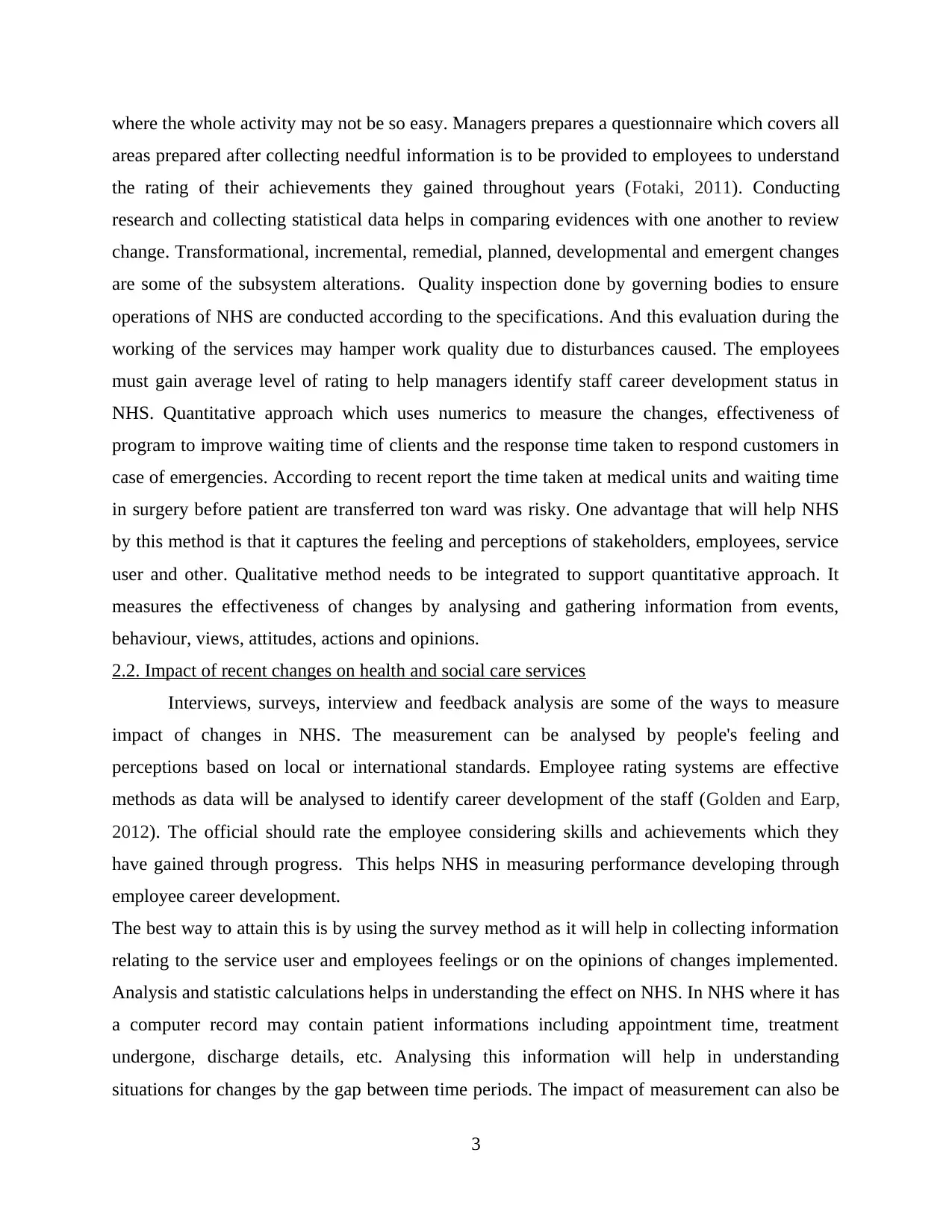
where the whole activity may not be so easy. Managers prepares a questionnaire which covers all
areas prepared after collecting needful information is to be provided to employees to understand
the rating of their achievements they gained throughout years (Fotaki, 2011). Conducting
research and collecting statistical data helps in comparing evidences with one another to review
change. Transformational, incremental, remedial, planned, developmental and emergent changes
are some of the subsystem alterations. Quality inspection done by governing bodies to ensure
operations of NHS are conducted according to the specifications. And this evaluation during the
working of the services may hamper work quality due to disturbances caused. The employees
must gain average level of rating to help managers identify staff career development status in
NHS. Quantitative approach which uses numerics to measure the changes, effectiveness of
program to improve waiting time of clients and the response time taken to respond customers in
case of emergencies. According to recent report the time taken at medical units and waiting time
in surgery before patient are transferred ton ward was risky. One advantage that will help NHS
by this method is that it captures the feeling and perceptions of stakeholders, employees, service
user and other. Qualitative method needs to be integrated to support quantitative approach. It
measures the effectiveness of changes by analysing and gathering information from events,
behaviour, views, attitudes, actions and opinions.
2.2. Impact of recent changes on health and social care services
Interviews, surveys, interview and feedback analysis are some of the ways to measure
impact of changes in NHS. The measurement can be analysed by people's feeling and
perceptions based on local or international standards. Employee rating systems are effective
methods as data will be analysed to identify career development of the staff (Golden and Earp,
2012). The official should rate the employee considering skills and achievements which they
have gained through progress. This helps NHS in measuring performance developing through
employee career development.
The best way to attain this is by using the survey method as it will help in collecting information
relating to the service user and employees feelings or on the opinions of changes implemented.
Analysis and statistic calculations helps in understanding the effect on NHS. In NHS where it has
a computer record may contain patient informations including appointment time, treatment
undergone, discharge details, etc. Analysing this information will help in understanding
situations for changes by the gap between time periods. The impact of measurement can also be
3
areas prepared after collecting needful information is to be provided to employees to understand
the rating of their achievements they gained throughout years (Fotaki, 2011). Conducting
research and collecting statistical data helps in comparing evidences with one another to review
change. Transformational, incremental, remedial, planned, developmental and emergent changes
are some of the subsystem alterations. Quality inspection done by governing bodies to ensure
operations of NHS are conducted according to the specifications. And this evaluation during the
working of the services may hamper work quality due to disturbances caused. The employees
must gain average level of rating to help managers identify staff career development status in
NHS. Quantitative approach which uses numerics to measure the changes, effectiveness of
program to improve waiting time of clients and the response time taken to respond customers in
case of emergencies. According to recent report the time taken at medical units and waiting time
in surgery before patient are transferred ton ward was risky. One advantage that will help NHS
by this method is that it captures the feeling and perceptions of stakeholders, employees, service
user and other. Qualitative method needs to be integrated to support quantitative approach. It
measures the effectiveness of changes by analysing and gathering information from events,
behaviour, views, attitudes, actions and opinions.
2.2. Impact of recent changes on health and social care services
Interviews, surveys, interview and feedback analysis are some of the ways to measure
impact of changes in NHS. The measurement can be analysed by people's feeling and
perceptions based on local or international standards. Employee rating systems are effective
methods as data will be analysed to identify career development of the staff (Golden and Earp,
2012). The official should rate the employee considering skills and achievements which they
have gained through progress. This helps NHS in measuring performance developing through
employee career development.
The best way to attain this is by using the survey method as it will help in collecting information
relating to the service user and employees feelings or on the opinions of changes implemented.
Analysis and statistic calculations helps in understanding the effect on NHS. In NHS where it has
a computer record may contain patient informations including appointment time, treatment
undergone, discharge details, etc. Analysing this information will help in understanding
situations for changes by the gap between time periods. The impact of measurement can also be
3
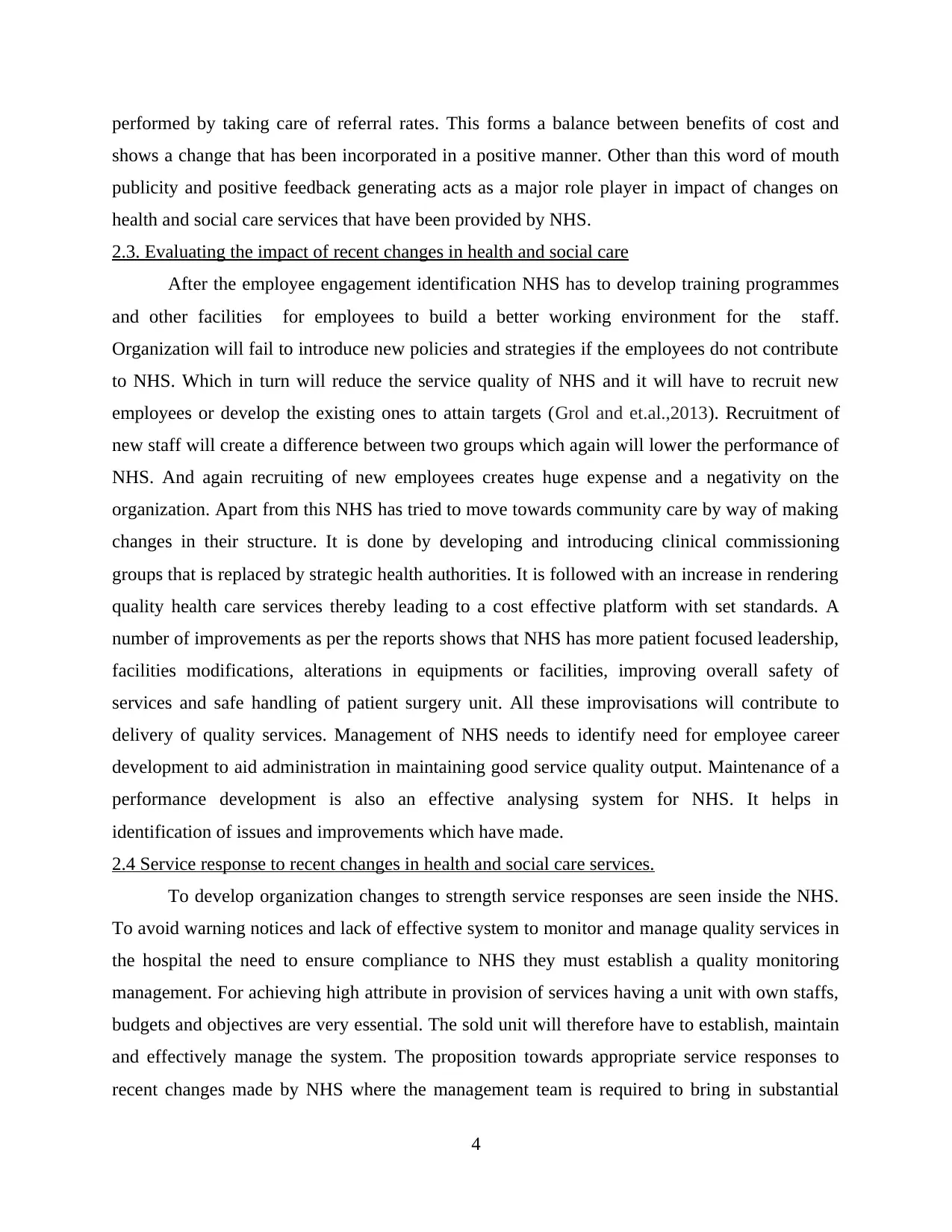
performed by taking care of referral rates. This forms a balance between benefits of cost and
shows a change that has been incorporated in a positive manner. Other than this word of mouth
publicity and positive feedback generating acts as a major role player in impact of changes on
health and social care services that have been provided by NHS.
2.3. Evaluating the impact of recent changes in health and social care
After the employee engagement identification NHS has to develop training programmes
and other facilities for employees to build a better working environment for the staff.
Organization will fail to introduce new policies and strategies if the employees do not contribute
to NHS. Which in turn will reduce the service quality of NHS and it will have to recruit new
employees or develop the existing ones to attain targets (Grol and et.al.,2013). Recruitment of
new staff will create a difference between two groups which again will lower the performance of
NHS. And again recruiting of new employees creates huge expense and a negativity on the
organization. Apart from this NHS has tried to move towards community care by way of making
changes in their structure. It is done by developing and introducing clinical commissioning
groups that is replaced by strategic health authorities. It is followed with an increase in rendering
quality health care services thereby leading to a cost effective platform with set standards. A
number of improvements as per the reports shows that NHS has more patient focused leadership,
facilities modifications, alterations in equipments or facilities, improving overall safety of
services and safe handling of patient surgery unit. All these improvisations will contribute to
delivery of quality services. Management of NHS needs to identify need for employee career
development to aid administration in maintaining good service quality output. Maintenance of a
performance development is also an effective analysing system for NHS. It helps in
identification of issues and improvements which have made.
2.4 Service response to recent changes in health and social care services.
To develop organization changes to strength service responses are seen inside the NHS.
To avoid warning notices and lack of effective system to monitor and manage quality services in
the hospital the need to ensure compliance to NHS they must establish a quality monitoring
management. For achieving high attribute in provision of services having a unit with own staffs,
budgets and objectives are very essential. The sold unit will therefore have to establish, maintain
and effectively manage the system. The proposition towards appropriate service responses to
recent changes made by NHS where the management team is required to bring in substantial
4
shows a change that has been incorporated in a positive manner. Other than this word of mouth
publicity and positive feedback generating acts as a major role player in impact of changes on
health and social care services that have been provided by NHS.
2.3. Evaluating the impact of recent changes in health and social care
After the employee engagement identification NHS has to develop training programmes
and other facilities for employees to build a better working environment for the staff.
Organization will fail to introduce new policies and strategies if the employees do not contribute
to NHS. Which in turn will reduce the service quality of NHS and it will have to recruit new
employees or develop the existing ones to attain targets (Grol and et.al.,2013). Recruitment of
new staff will create a difference between two groups which again will lower the performance of
NHS. And again recruiting of new employees creates huge expense and a negativity on the
organization. Apart from this NHS has tried to move towards community care by way of making
changes in their structure. It is done by developing and introducing clinical commissioning
groups that is replaced by strategic health authorities. It is followed with an increase in rendering
quality health care services thereby leading to a cost effective platform with set standards. A
number of improvements as per the reports shows that NHS has more patient focused leadership,
facilities modifications, alterations in equipments or facilities, improving overall safety of
services and safe handling of patient surgery unit. All these improvisations will contribute to
delivery of quality services. Management of NHS needs to identify need for employee career
development to aid administration in maintaining good service quality output. Maintenance of a
performance development is also an effective analysing system for NHS. It helps in
identification of issues and improvements which have made.
2.4 Service response to recent changes in health and social care services.
To develop organization changes to strength service responses are seen inside the NHS.
To avoid warning notices and lack of effective system to monitor and manage quality services in
the hospital the need to ensure compliance to NHS they must establish a quality monitoring
management. For achieving high attribute in provision of services having a unit with own staffs,
budgets and objectives are very essential. The sold unit will therefore have to establish, maintain
and effectively manage the system. The proposition towards appropriate service responses to
recent changes made by NHS where the management team is required to bring in substantial
4
⊘ This is a preview!⊘
Do you want full access?
Subscribe today to unlock all pages.

Trusted by 1+ million students worldwide
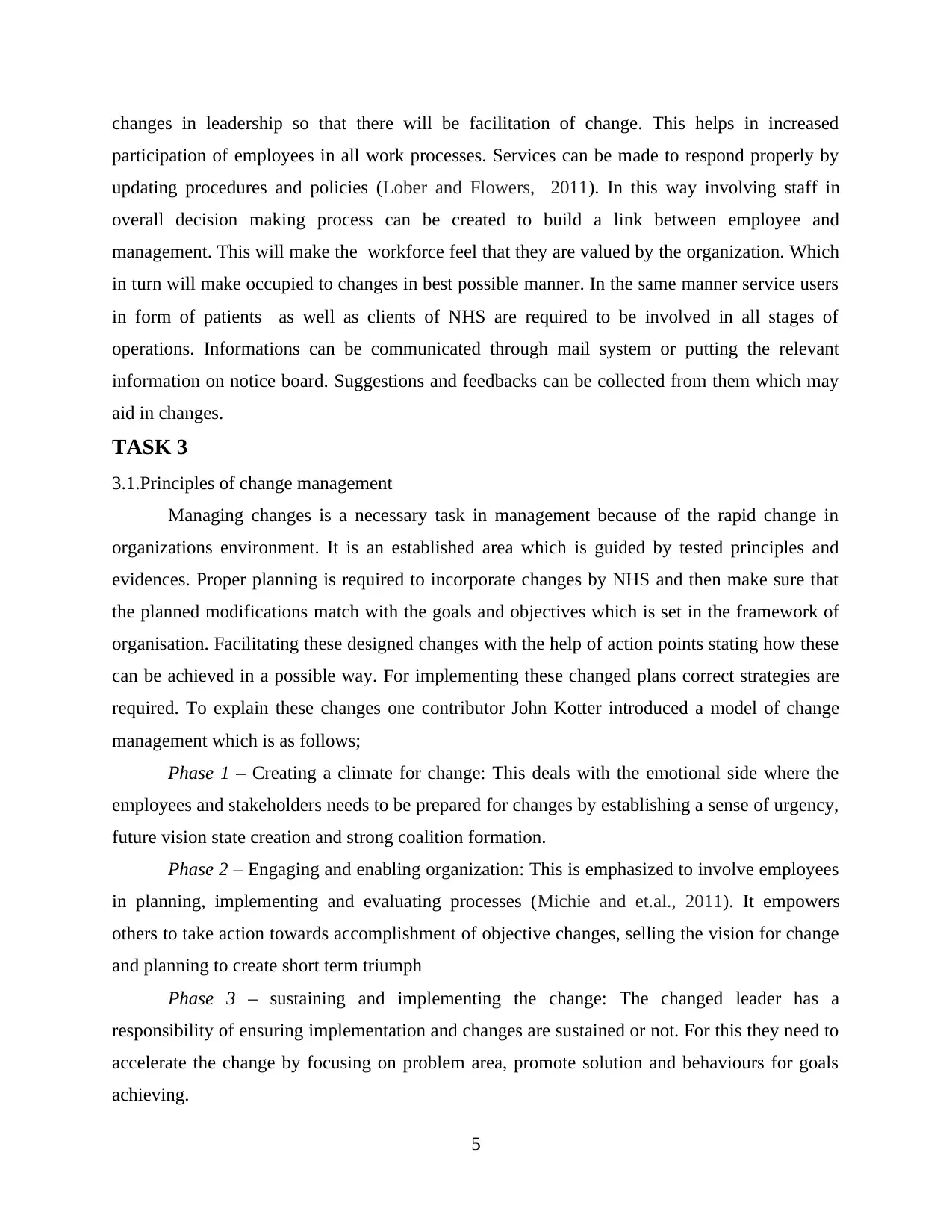
changes in leadership so that there will be facilitation of change. This helps in increased
participation of employees in all work processes. Services can be made to respond properly by
updating procedures and policies (Lober and Flowers, 2011). In this way involving staff in
overall decision making process can be created to build a link between employee and
management. This will make the workforce feel that they are valued by the organization. Which
in turn will make occupied to changes in best possible manner. In the same manner service users
in form of patients as well as clients of NHS are required to be involved in all stages of
operations. Informations can be communicated through mail system or putting the relevant
information on notice board. Suggestions and feedbacks can be collected from them which may
aid in changes.
TASK 3
3.1.Principles of change management
Managing changes is a necessary task in management because of the rapid change in
organizations environment. It is an established area which is guided by tested principles and
evidences. Proper planning is required to incorporate changes by NHS and then make sure that
the planned modifications match with the goals and objectives which is set in the framework of
organisation. Facilitating these designed changes with the help of action points stating how these
can be achieved in a possible way. For implementing these changed plans correct strategies are
required. To explain these changes one contributor John Kotter introduced a model of change
management which is as follows;
Phase 1 – Creating a climate for change: This deals with the emotional side where the
employees and stakeholders needs to be prepared for changes by establishing a sense of urgency,
future vision state creation and strong coalition formation.
Phase 2 – Engaging and enabling organization: This is emphasized to involve employees
in planning, implementing and evaluating processes (Michie and et.al., 2011). It empowers
others to take action towards accomplishment of objective changes, selling the vision for change
and planning to create short term triumph
Phase 3 – sustaining and implementing the change: The changed leader has a
responsibility of ensuring implementation and changes are sustained or not. For this they need to
accelerate the change by focusing on problem area, promote solution and behaviours for goals
achieving.
5
participation of employees in all work processes. Services can be made to respond properly by
updating procedures and policies (Lober and Flowers, 2011). In this way involving staff in
overall decision making process can be created to build a link between employee and
management. This will make the workforce feel that they are valued by the organization. Which
in turn will make occupied to changes in best possible manner. In the same manner service users
in form of patients as well as clients of NHS are required to be involved in all stages of
operations. Informations can be communicated through mail system or putting the relevant
information on notice board. Suggestions and feedbacks can be collected from them which may
aid in changes.
TASK 3
3.1.Principles of change management
Managing changes is a necessary task in management because of the rapid change in
organizations environment. It is an established area which is guided by tested principles and
evidences. Proper planning is required to incorporate changes by NHS and then make sure that
the planned modifications match with the goals and objectives which is set in the framework of
organisation. Facilitating these designed changes with the help of action points stating how these
can be achieved in a possible way. For implementing these changed plans correct strategies are
required. To explain these changes one contributor John Kotter introduced a model of change
management which is as follows;
Phase 1 – Creating a climate for change: This deals with the emotional side where the
employees and stakeholders needs to be prepared for changes by establishing a sense of urgency,
future vision state creation and strong coalition formation.
Phase 2 – Engaging and enabling organization: This is emphasized to involve employees
in planning, implementing and evaluating processes (Michie and et.al., 2011). It empowers
others to take action towards accomplishment of objective changes, selling the vision for change
and planning to create short term triumph
Phase 3 – sustaining and implementing the change: The changed leader has a
responsibility of ensuring implementation and changes are sustained or not. For this they need to
accelerate the change by focusing on problem area, promote solution and behaviours for goals
achieving.
5
Paraphrase This Document
Need a fresh take? Get an instant paraphrase of this document with our AI Paraphraser
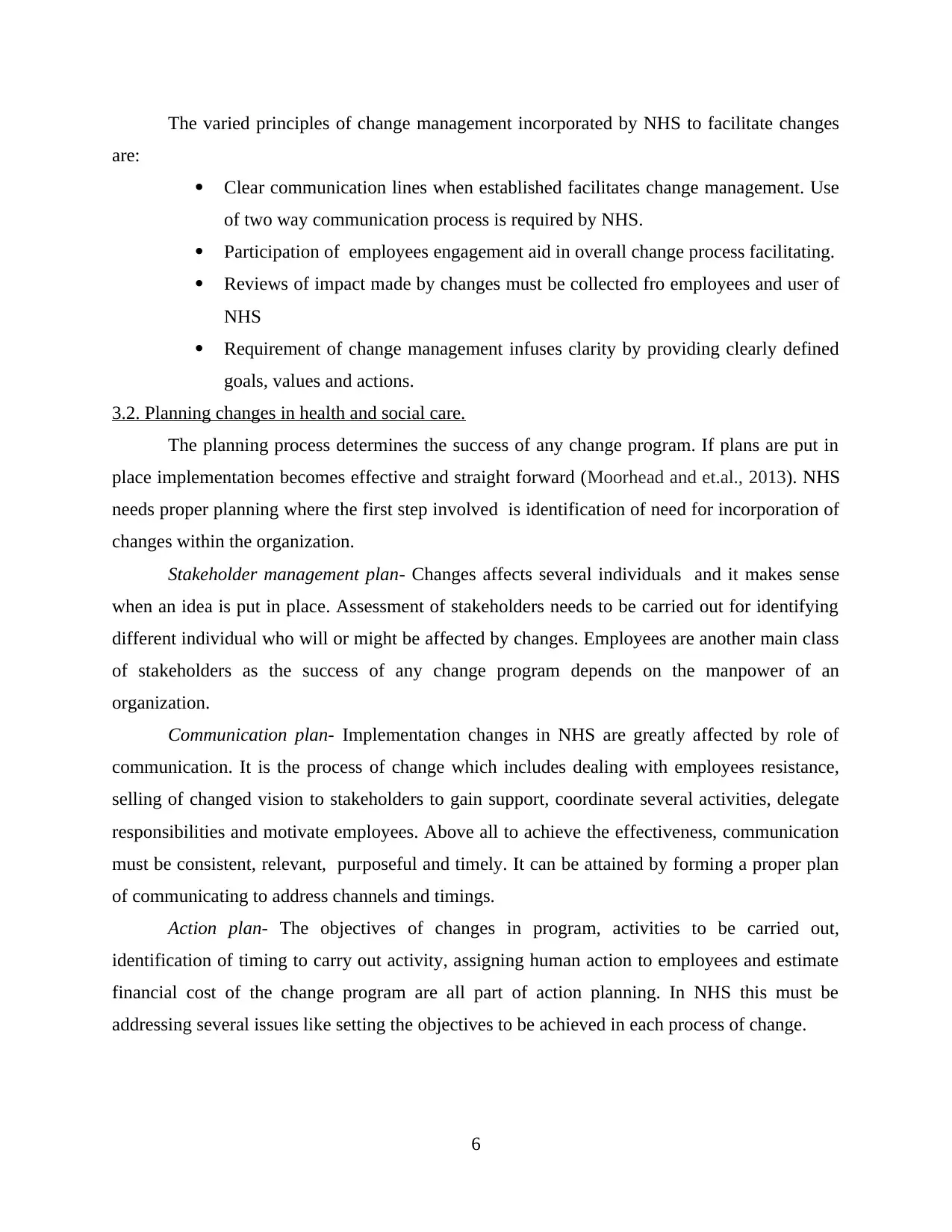
The varied principles of change management incorporated by NHS to facilitate changes
are:
Clear communication lines when established facilitates change management. Use
of two way communication process is required by NHS.
Participation of employees engagement aid in overall change process facilitating.
Reviews of impact made by changes must be collected fro employees and user of
NHS
Requirement of change management infuses clarity by providing clearly defined
goals, values and actions.
3.2. Planning changes in health and social care.
The planning process determines the success of any change program. If plans are put in
place implementation becomes effective and straight forward (Moorhead and et.al., 2013). NHS
needs proper planning where the first step involved is identification of need for incorporation of
changes within the organization.
Stakeholder management plan- Changes affects several individuals and it makes sense
when an idea is put in place. Assessment of stakeholders needs to be carried out for identifying
different individual who will or might be affected by changes. Employees are another main class
of stakeholders as the success of any change program depends on the manpower of an
organization.
Communication plan- Implementation changes in NHS are greatly affected by role of
communication. It is the process of change which includes dealing with employees resistance,
selling of changed vision to stakeholders to gain support, coordinate several activities, delegate
responsibilities and motivate employees. Above all to achieve the effectiveness, communication
must be consistent, relevant, purposeful and timely. It can be attained by forming a proper plan
of communicating to address channels and timings.
Action plan- The objectives of changes in program, activities to be carried out,
identification of timing to carry out activity, assigning human action to employees and estimate
financial cost of the change program are all part of action planning. In NHS this must be
addressing several issues like setting the objectives to be achieved in each process of change.
6
are:
Clear communication lines when established facilitates change management. Use
of two way communication process is required by NHS.
Participation of employees engagement aid in overall change process facilitating.
Reviews of impact made by changes must be collected fro employees and user of
NHS
Requirement of change management infuses clarity by providing clearly defined
goals, values and actions.
3.2. Planning changes in health and social care.
The planning process determines the success of any change program. If plans are put in
place implementation becomes effective and straight forward (Moorhead and et.al., 2013). NHS
needs proper planning where the first step involved is identification of need for incorporation of
changes within the organization.
Stakeholder management plan- Changes affects several individuals and it makes sense
when an idea is put in place. Assessment of stakeholders needs to be carried out for identifying
different individual who will or might be affected by changes. Employees are another main class
of stakeholders as the success of any change program depends on the manpower of an
organization.
Communication plan- Implementation changes in NHS are greatly affected by role of
communication. It is the process of change which includes dealing with employees resistance,
selling of changed vision to stakeholders to gain support, coordinate several activities, delegate
responsibilities and motivate employees. Above all to achieve the effectiveness, communication
must be consistent, relevant, purposeful and timely. It can be attained by forming a proper plan
of communicating to address channels and timings.
Action plan- The objectives of changes in program, activities to be carried out,
identification of timing to carry out activity, assigning human action to employees and estimate
financial cost of the change program are all part of action planning. In NHS this must be
addressing several issues like setting the objectives to be achieved in each process of change.
6
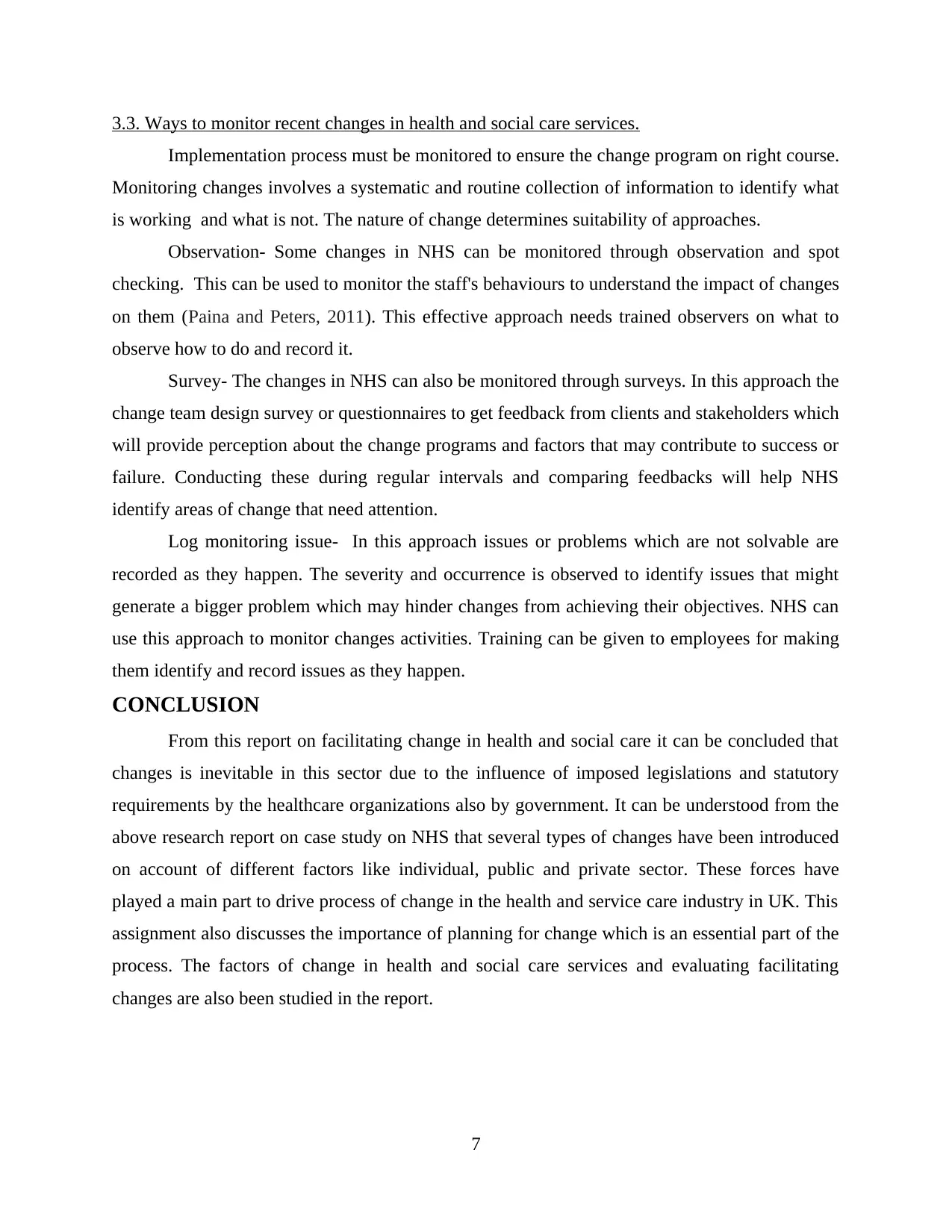
3.3. Ways to monitor recent changes in health and social care services.
Implementation process must be monitored to ensure the change program on right course.
Monitoring changes involves a systematic and routine collection of information to identify what
is working and what is not. The nature of change determines suitability of approaches.
Observation- Some changes in NHS can be monitored through observation and spot
checking. This can be used to monitor the staff's behaviours to understand the impact of changes
on them (Paina and Peters, 2011). This effective approach needs trained observers on what to
observe how to do and record it.
Survey- The changes in NHS can also be monitored through surveys. In this approach the
change team design survey or questionnaires to get feedback from clients and stakeholders which
will provide perception about the change programs and factors that may contribute to success or
failure. Conducting these during regular intervals and comparing feedbacks will help NHS
identify areas of change that need attention.
Log monitoring issue- In this approach issues or problems which are not solvable are
recorded as they happen. The severity and occurrence is observed to identify issues that might
generate a bigger problem which may hinder changes from achieving their objectives. NHS can
use this approach to monitor changes activities. Training can be given to employees for making
them identify and record issues as they happen.
CONCLUSION
From this report on facilitating change in health and social care it can be concluded that
changes is inevitable in this sector due to the influence of imposed legislations and statutory
requirements by the healthcare organizations also by government. It can be understood from the
above research report on case study on NHS that several types of changes have been introduced
on account of different factors like individual, public and private sector. These forces have
played a main part to drive process of change in the health and service care industry in UK. This
assignment also discusses the importance of planning for change which is an essential part of the
process. The factors of change in health and social care services and evaluating facilitating
changes are also been studied in the report.
7
Implementation process must be monitored to ensure the change program on right course.
Monitoring changes involves a systematic and routine collection of information to identify what
is working and what is not. The nature of change determines suitability of approaches.
Observation- Some changes in NHS can be monitored through observation and spot
checking. This can be used to monitor the staff's behaviours to understand the impact of changes
on them (Paina and Peters, 2011). This effective approach needs trained observers on what to
observe how to do and record it.
Survey- The changes in NHS can also be monitored through surveys. In this approach the
change team design survey or questionnaires to get feedback from clients and stakeholders which
will provide perception about the change programs and factors that may contribute to success or
failure. Conducting these during regular intervals and comparing feedbacks will help NHS
identify areas of change that need attention.
Log monitoring issue- In this approach issues or problems which are not solvable are
recorded as they happen. The severity and occurrence is observed to identify issues that might
generate a bigger problem which may hinder changes from achieving their objectives. NHS can
use this approach to monitor changes activities. Training can be given to employees for making
them identify and record issues as they happen.
CONCLUSION
From this report on facilitating change in health and social care it can be concluded that
changes is inevitable in this sector due to the influence of imposed legislations and statutory
requirements by the healthcare organizations also by government. It can be understood from the
above research report on case study on NHS that several types of changes have been introduced
on account of different factors like individual, public and private sector. These forces have
played a main part to drive process of change in the health and service care industry in UK. This
assignment also discusses the importance of planning for change which is an essential part of the
process. The factors of change in health and social care services and evaluating facilitating
changes are also been studied in the report.
7
⊘ This is a preview!⊘
Do you want full access?
Subscribe today to unlock all pages.

Trusted by 1+ million students worldwide
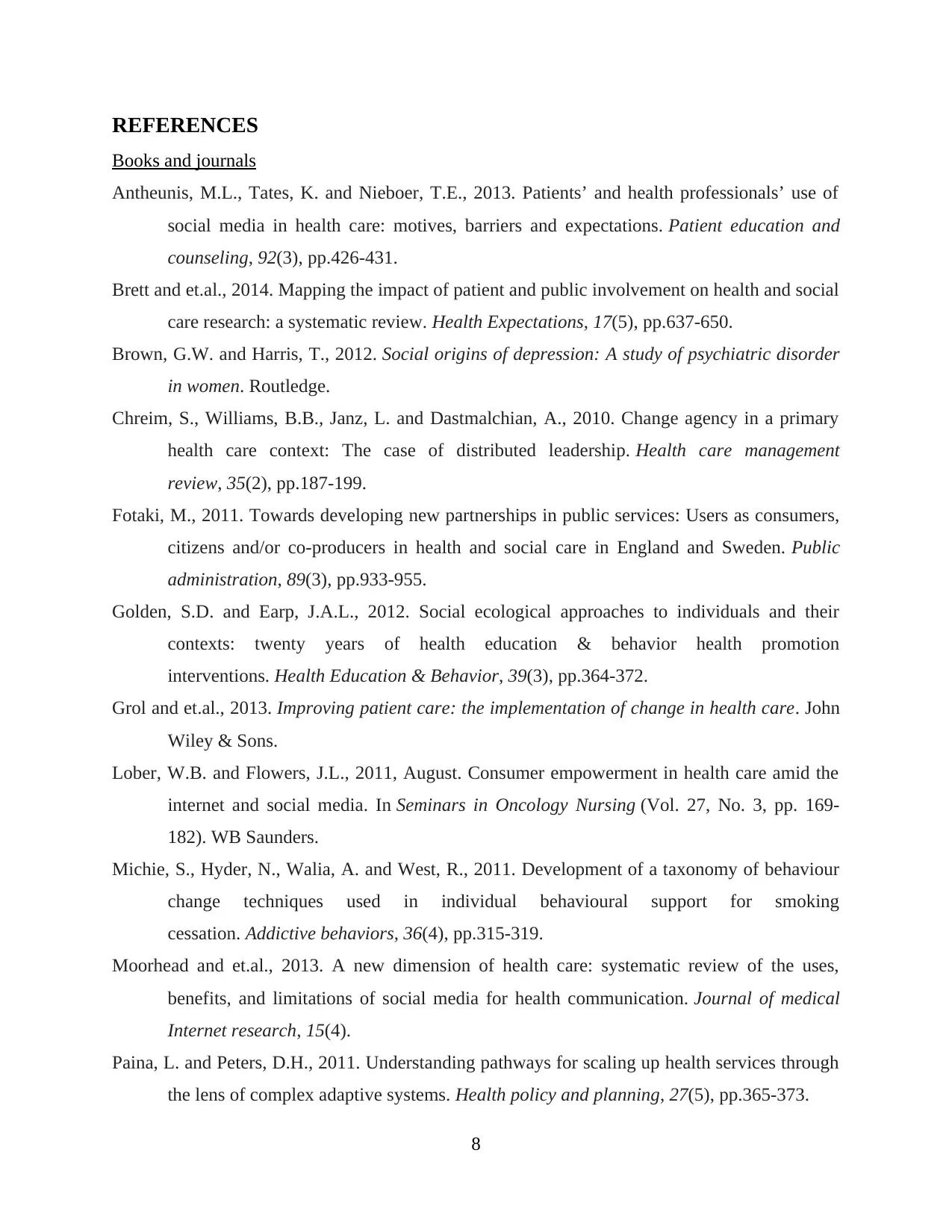
REFERENCES
Books and journals
Antheunis, M.L., Tates, K. and Nieboer, T.E., 2013. Patients’ and health professionals’ use of
social media in health care: motives, barriers and expectations. Patient education and
counseling, 92(3), pp.426-431.
Brett and et.al., 2014. Mapping the impact of patient and public involvement on health and social
care research: a systematic review. Health Expectations, 17(5), pp.637-650.
Brown, G.W. and Harris, T., 2012. Social origins of depression: A study of psychiatric disorder
in women. Routledge.
Chreim, S., Williams, B.B., Janz, L. and Dastmalchian, A., 2010. Change agency in a primary
health care context: The case of distributed leadership. Health care management
review, 35(2), pp.187-199.
Fotaki, M., 2011. Towards developing new partnerships in public services: Users as consumers,
citizens and/or co‐producers in health and social care in England and Sweden. Public
administration, 89(3), pp.933-955.
Golden, S.D. and Earp, J.A.L., 2012. Social ecological approaches to individuals and their
contexts: twenty years of health education & behavior health promotion
interventions. Health Education & Behavior, 39(3), pp.364-372.
Grol and et.al., 2013. Improving patient care: the implementation of change in health care. John
Wiley & Sons.
Lober, W.B. and Flowers, J.L., 2011, August. Consumer empowerment in health care amid the
internet and social media. In Seminars in Oncology Nursing (Vol. 27, No. 3, pp. 169-
182). WB Saunders.
Michie, S., Hyder, N., Walia, A. and West, R., 2011. Development of a taxonomy of behaviour
change techniques used in individual behavioural support for smoking
cessation. Addictive behaviors, 36(4), pp.315-319.
Moorhead and et.al., 2013. A new dimension of health care: systematic review of the uses,
benefits, and limitations of social media for health communication. Journal of medical
Internet research, 15(4).
Paina, L. and Peters, D.H., 2011. Understanding pathways for scaling up health services through
the lens of complex adaptive systems. Health policy and planning, 27(5), pp.365-373.
8
Books and journals
Antheunis, M.L., Tates, K. and Nieboer, T.E., 2013. Patients’ and health professionals’ use of
social media in health care: motives, barriers and expectations. Patient education and
counseling, 92(3), pp.426-431.
Brett and et.al., 2014. Mapping the impact of patient and public involvement on health and social
care research: a systematic review. Health Expectations, 17(5), pp.637-650.
Brown, G.W. and Harris, T., 2012. Social origins of depression: A study of psychiatric disorder
in women. Routledge.
Chreim, S., Williams, B.B., Janz, L. and Dastmalchian, A., 2010. Change agency in a primary
health care context: The case of distributed leadership. Health care management
review, 35(2), pp.187-199.
Fotaki, M., 2011. Towards developing new partnerships in public services: Users as consumers,
citizens and/or co‐producers in health and social care in England and Sweden. Public
administration, 89(3), pp.933-955.
Golden, S.D. and Earp, J.A.L., 2012. Social ecological approaches to individuals and their
contexts: twenty years of health education & behavior health promotion
interventions. Health Education & Behavior, 39(3), pp.364-372.
Grol and et.al., 2013. Improving patient care: the implementation of change in health care. John
Wiley & Sons.
Lober, W.B. and Flowers, J.L., 2011, August. Consumer empowerment in health care amid the
internet and social media. In Seminars in Oncology Nursing (Vol. 27, No. 3, pp. 169-
182). WB Saunders.
Michie, S., Hyder, N., Walia, A. and West, R., 2011. Development of a taxonomy of behaviour
change techniques used in individual behavioural support for smoking
cessation. Addictive behaviors, 36(4), pp.315-319.
Moorhead and et.al., 2013. A new dimension of health care: systematic review of the uses,
benefits, and limitations of social media for health communication. Journal of medical
Internet research, 15(4).
Paina, L. and Peters, D.H., 2011. Understanding pathways for scaling up health services through
the lens of complex adaptive systems. Health policy and planning, 27(5), pp.365-373.
8
Paraphrase This Document
Need a fresh take? Get an instant paraphrase of this document with our AI Paraphraser
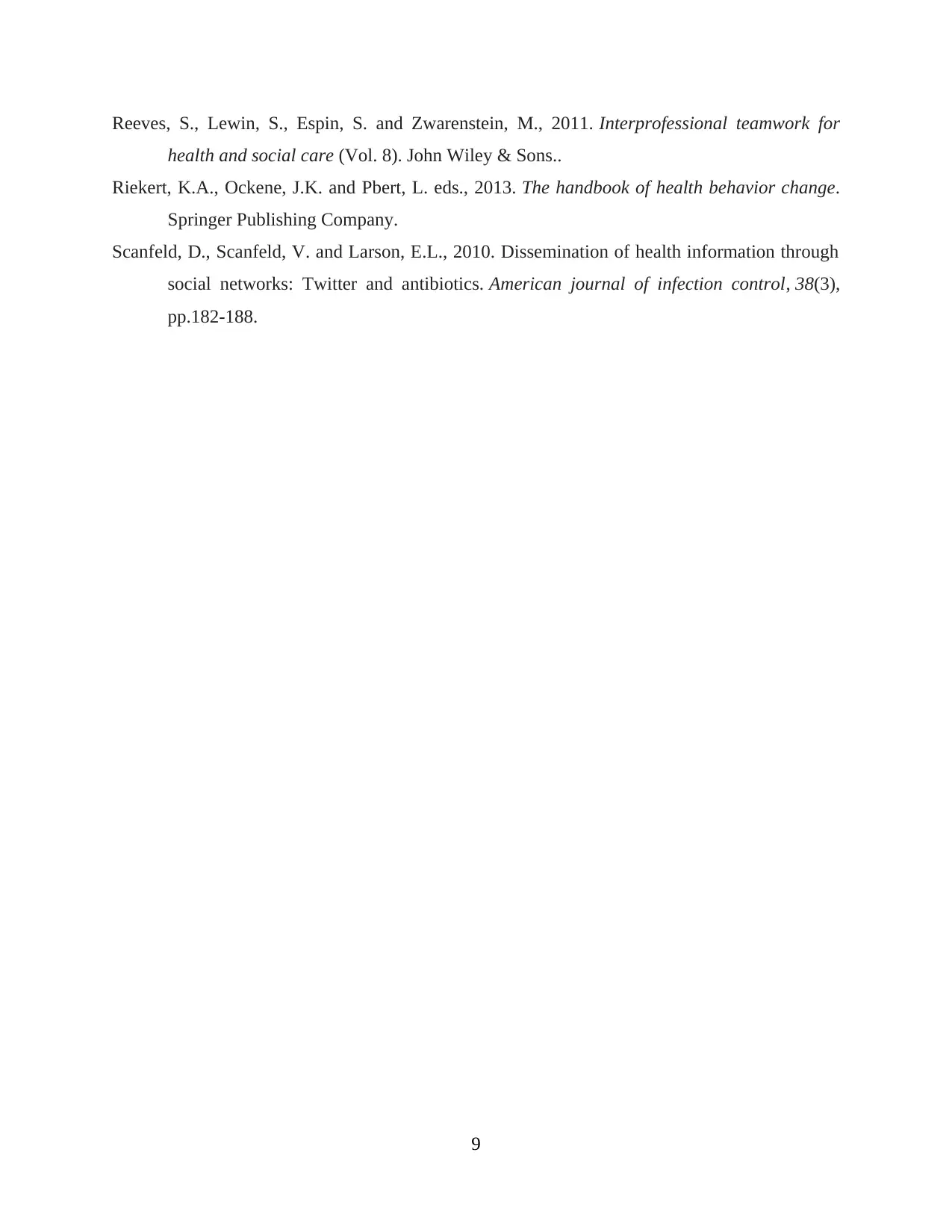
Reeves, S., Lewin, S., Espin, S. and Zwarenstein, M., 2011. Interprofessional teamwork for
health and social care (Vol. 8). John Wiley & Sons..
Riekert, K.A., Ockene, J.K. and Pbert, L. eds., 2013. The handbook of health behavior change.
Springer Publishing Company.
Scanfeld, D., Scanfeld, V. and Larson, E.L., 2010. Dissemination of health information through
social networks: Twitter and antibiotics. American journal of infection control, 38(3),
pp.182-188.
9
health and social care (Vol. 8). John Wiley & Sons..
Riekert, K.A., Ockene, J.K. and Pbert, L. eds., 2013. The handbook of health behavior change.
Springer Publishing Company.
Scanfeld, D., Scanfeld, V. and Larson, E.L., 2010. Dissemination of health information through
social networks: Twitter and antibiotics. American journal of infection control, 38(3),
pp.182-188.
9
1 out of 11
Related Documents
Your All-in-One AI-Powered Toolkit for Academic Success.
+13062052269
info@desklib.com
Available 24*7 on WhatsApp / Email
![[object Object]](/_next/static/media/star-bottom.7253800d.svg)
Unlock your academic potential
Copyright © 2020–2025 A2Z Services. All Rights Reserved. Developed and managed by ZUCOL.





